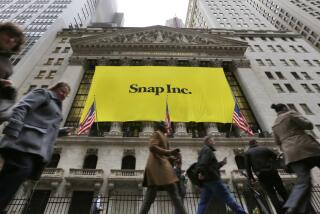Going Public Still Iffy for Private Firms : Markets: Since 1987, the number of companies selling stock for the first time has dropped sharply. But the tide may turn before year’s end.
- Share via
In mid-January, Tri-Care Inc. announced plans to raise $10.4 million in an initial public offering. The Santa Ana-based firm, which provides medical evaluations used to resolve disputed workers’ compensation claims, completed the stock sale Jan. 26.
In early February, I-Flow Corp., an Irvine-based start-up company developing an intravenous drug-delivery product, raised $2.6 million with the issuance of an IPO.
And on Feb. 12, Tokos Parent Co., a Santa Ana home-health-care company that makes a device for detecting the onset of premature labor, said it would raise $30 million next month with its first public stock offering.
“These are the first significant public offerings in the county in the last 18 months,” said Jeff Kilpatrick, president of Newport Securities, a Costa Mesa securities brokerage firm that closely follows Orange County public companies.
Other local companies are considering going public as well. For instance, Advanced Logic Research, an Irvine personal computer maker, is expected to make a long-contemplated public debut soon.
This cloudburst of activity in Orange County would seem to indicate that the long dry spell for IPOs is over. But stock market forecasters are quick to point out that its takes more than a couple of downpours to end an extended drought.
“We haven’t had that kind of scenario for nearly five years, and we are grossly overdue for such a period,” said Kilpatrick, who said poor market conditions are hobbling some small, up-and-coming Orange County companies that need an infusion of public money to continue their growth.
Most industry analysts do not believe an explosion of IPOs is on the horizon for several reasons, including the stock market’s recent gyrations and concerns about the economy.
“The stock market has been very volatile, and people are predicting the end of a bull market, and that bodes poorly for IPOs,” said Aaron Pressman, staff writer for Going Public: The IPO Reporter, a weekly newsletter published by Investment Dealers’ Digest in New York.
According to the newsletter, the number of companies going public in the country fell sharply after the October, 1987, stock market crash and has remained low ever since.
In 1986, 694 firms made initial public offerings and raised $18.26 billion, compared to 216 firms that went public in 1988, raising $5.95 billion, and 203 that went public in 1989, raising $6.25 billion.
Still, Kilpatrick said a resurgence of IPOs could occur in the next six months if the securities market is stable and the economy remains strong.
Another factor that could spur more IPOs, securities industry officials say, is the disenchantment with junk bonds newly experienced by investors and underwriters who, as a consequence, are looking for other kinds of ventures to support.
Also, passage of a proposal before Congress to reduce the capital gains tax could make the entire stock market, including IPOs, more attractive.
For young companies to get a good price for their stock in an IPO today, market experts said, they must show exceptional earnings potential. Also, it doesn’t hurt for them to be in one of the handful of industries that are currently “hot” on Wall Street.
All three of the Orange County firms that recently chose to go public are in one such field: health care.
Pressman said the 11 health-care companies that went public last year outperformed IPOs in every other business sector. During the year the value of their stock increased an average of 71%, contrasted with an average increase of 17% for all IPOs.
Analysts also say the stock market is especially receptive to oil service, computer software and environmental technology companies.
“For certain niches, IPOs are growing. But on the whole, it (the market for IPOs) is pretty cold,” Pressman said.
As an alternative to raising expansion capital on the stock market, some companies have arranged private sales of stock to institutions or have merged with larger corporations in leveraged buyouts. In other cases, venture capital investors that fund companies in their initial stages are waiting to liquidate their investments until stock market conditions improve.
Some companies are eager for the stock market window to squeeze open a little more so they can obtain money they need to take advantage of a pressing business opportunity.
Larry Velie, chief executive and major owner in Velie Circuits Inc., a private Costa Mesa firm that makes printed computer circuit boards, said that although the 5-year-old company has shown substantial growth, stock market investors wouldn’t regard it as having the same “sizzle” as a health-care business.
FEWER COMPANIES GOING PUBLIC Value of stock issued (In millions of dollars) 1978: $214 1986: $18,259 1989: $6,248 Number of companies going public 1978: 18 1986: 694 1989: 203 Source: IDD Information Services
More to Read
Inside the business of entertainment
The Wide Shot brings you news, analysis and insights on everything from streaming wars to production — and what it all means for the future.
You may occasionally receive promotional content from the Los Angeles Times.










